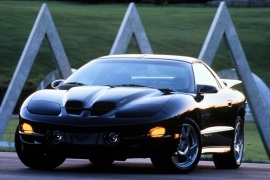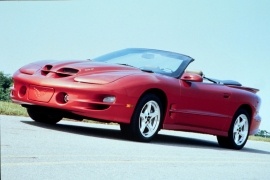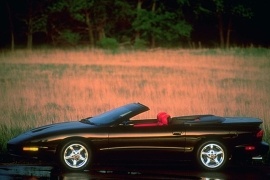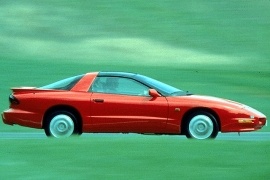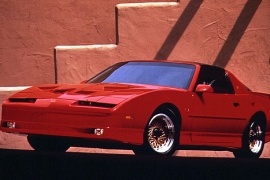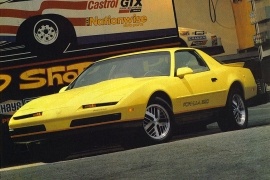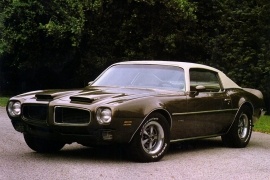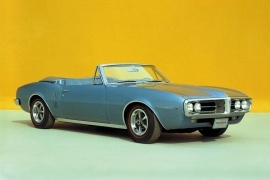PONTIAC Firebird Models/Series Timeline, Specifications & Photos
First production year: 1967
Engines: Gasoline
In 2000, Pontiac released the last sequel o its Firebird, and, even though it wasn't a new vehicle, it was an important refresh. But that didn't save the nameplate.
While it was still a competitive car on the market, it was overshadowed by its Camaro sibling. It was considered a sports car, and while it lacked the same performances as a Corvette, it was lower priced than it. Its main competitor from outside GM was the Mustang. Unlike the blue-oval contender, Pontiac bragged about its pop-up headlights, even though those were outdated for almost two decades.
For the last refresh, the carmaker installed a revised hood with two bulges that opened at the front with a pair of nostrils-looking air-intakes. Moreover, it removed the exhaust vents, and that led to a better airflow into the engine compartment and especially to the air filter installed on top of the engine. Another major improvement was the V-shaped bumper, which incorporated a pair of foglights mounted closer to the car's center, not on the outer sides. Last but not least, the headlights featured two lamps on each side instead of one as on the rest of the Firebirds. A set of aerodynamically profiled door mirrors and a wing on the trunk completed the car's aggressive look.
The Firebird featured high-bolstered bucket seats that supported the passengers during high-cornering maneuvers. But, just like the non-facelifted version, it didn't provide enough room for rear passengers. Yet, Pontiac still insisted on installing a bench in the back, which proved to be very useful for a sports bag or a backpack.
Under the hood, Pontiac installed a 3.8-liter V6 engine for those who didn't really care about performance, while those eager to hit the gas on a drag strip were granted a V8 powerplant.
Pontiac was eager to get a better engine for its TransAm Firebird, and it made the RamAir version, which looked wild, and then the carmaker made a convertible out of it.
In 2000, the Pontiac was still riding the high tides, and its cars were selling well, especially the Firebird. It was a sports car, but not as harsh or expensive as a Corvette. It competed against its sibling, the Camaro, and the Mustang, but its pop-up headlights were different, which attracted the customers who were teenagers in the '80s
The main difference was that the carmaker installed a new hood with two bulges opened at the front. Thus, it removed the exhaust vents and tracked more air into the air filter installed just under the nostrils-looking air-intakes. Its bumper was still V-shaped as in the 1997 model but incorporated a pair of wide fog lights placed closer to the car's center. Last but not least, the headlights featured two lamps on each side instead of one as on the rest of the Firebirds. A set of aerodynamically profiled door mirrors and a wing on the trunk enhanced the car's aggressive look. Pontiac offered the RamAir version in three body shapes: coupe, T-top, and convertible.
Inside the cabin, the carmaker ditched the comfortable seats and introduced a pair of high-bolstered bucket seats that provided much better side support. Its front independent suspension and the solid rear axle were not the best choices for a handling vehicle, but they worked well for wide turns on a fast track. The center stack looked very similar to the '97 model but with a CD player on it. Its seven-channel equalizer was challenging to use while driving. But that wasn't a real problem for as long as its customers had the music of a V-8.
Pontiac introduced a convertible version for the Firebird's fourth generation in 1994 as a 1995 model year and raised the bar against its main rival, the Ford Mustang.
The pony-car war never ended. It just evolved into a different area. While in the beginning was all about horsepower, later on, it was about features and amenities. When Pontiac introduced the fourth generation of the Firebird in 1992, it offered it either as a coupe or as a T-top, which was the next best thing to a convertible. But the true rag-top version came only in 1994.
Designed as a more aerodynamic, GT-style vehicle, the Firebird featured a pair of pop-up headlights and a V-shaped front bumper. It had no grille, just a few air-intakes to cool the radiators and feed the engine with air. A pair of hood vents served as hot-air extractors. Pontiac made the Firebird convertible with thick A-pillars, which served as a safety arch as well. Behind the cabin, the carmaker made the storage area for the canvas top in front of the flat trunk lid. An important improvement for the car was the glass, defrosted rear window.
Inside, Pontiac installed two seats at the front and a bench behind them, but with very limited legroom for the rear passengers. Depending on the trim level, the carmaker offered bucket seats with high bolstering for the front occupants. A tall center console divided the car in two. The rounded instrument cluster featured two large dials for the speedometer and tachometer. Another four gauges underneath and on the sides show the oil pressure and the ammeter apart the regular fuel level and temperature indicators.
Under the hood, the Firebird convertible featured a small engine range starting with a 3.4-liter V-6 and topping up with a 5.7-liter V-8 for the Firebird Formula version.
Pontiac introduced the fourth generation of the Firebird pony car in 1994, raising the bar against its main rival, the Ford Mustang, even though its main competitor proved to be its sibling, the Chevy Camaro.
The 1994 Firebird was the last of its kind and was basically a badge-engineered product with the Chevrolet Camaro. Yet, it had unique features that made it more desirable for many.
While for other carmakers, the era of pop-up headlights was already gone, the Firebird still used them. They actually looked cool for those times' standards and allowed the car to feature a sharp nose. Depending on the version, the Firebird Coupe also featured a pair of vents on the hood and, later on, two nostrils. Its wide and raked windshield ensured an excellent view for the driver, while the roof was available with a T-top made from two smoked glass panels. At the back, the sloped rear windscreen covered the wide, but not that deep, trunk.
Inside, the carmaker focused on the front passengers and offered the Firebird a pair of bucket seats with high bolstered areas. Depending on the trim level and options, it received leather seats. In the back, the cramped bench was profiled for two. While it was difficult to slide someone in there, it was even worse for tall passengers. The driver, on the other hand, was spoiled with a curved dashboard.
Under the hood, the Firebird received a choice of two engines: a 3.4-liter V6 and a 5.7-liter V8 (the LT1). Later on, the car was granted access to the LS1 engine.
Pontiac faced a difficult situation: on one hand, it knew that it had to replace the model, and on the other hand, the new generation wasn't ready.
Thus, in the late '80s and the beginning of the '90s, it tried to keep the car fresh on the market with different versions or addition. In addition, it tried to lower the car's costs, even though that meant decreasing the quality of some non-essential parts, such as the door cards.
Pontiac had experimented with a few variations for the Firebird's bodywork. Strangely, even a notchback design was offered as an option for the Firebird. Nevertheless, that was not very attractive to customers, who preferred the elegant sloped-down liftgate behind the cabin. Another unusual option for the Firebird was the restyled nose that extended the car's front with an aerodynamically profiled bumper, making the car look sharper. That idea was carried over to its successor, which was launched in 1993.
Inside, the Firebird still sported the same high-bolstered bucket seats at the front, meant to provide enough side support for their occupants during high-speed cornering maneuvers. The overall interior design was showing its age, and only the optional CD player looked appropriate for those times. The AC was standard for the V8 model and optional for the V6 version.
Apart from the thrilling Trans Am GTA model, the rest of the range was not very special. Still, its engine lineup was strong enough. The 5.0-liter V8 powerplant was good enough to deliver over 200 ponies.
Pontiac introduced the Firebird Trans-Am in 1982 as a 1983 model and shared most of its components with the Chevrolet Camaro but styled differently.
It was the car from the Night Rider movie, and that "KITT" made it famous worldwide. At the beginning of the '80s, the former glorious muscle cars were stripped by their big V-8 engines due to pollution regulations, and their powers were down to two-digits figures. But that didn't mean that the carmakers couldn't make them look hot, such as the 1982 Firebird.
The pop-up headlights were something that everybody craved for, and the Firebird had them. Its narrow front end with a plastic, wrapped-around bumper featured fog lights as an option. When the headlights were shut, they left a small gap. From its sides, the raked windshield was typical for a sports car. Its greenhouse was extended in the back with a huge, curved rear window.
Inside, it wasn't that high-tech, futuristic cabin such as the one from the Night Rider. Inside, the Firebird featured large, round dials on the instrument panel. Its dashboard was straight, with a center stack for the radio and the air-conditioning unit. Depending on the trim level, the center console sported the automatic gear-selector or the gear-stick for the manual gearbox. The car featured power-adjustable front seats on the upper trim levels, while a folding bench was standard for the rear passengers.
Under the hood, Pontiac installed a 2.5-liter engine for the base model and V-8s for the rest of the range.
Pontiac introduced the second generation of the Firebird in February 1970, which was a re-badged version of the Chevrolet Camaro.
In 1979, GM needed to change the production line where the Camaro and the Firebird were produced to start the second generation of these vehicles. Due to several problems, that process was delayed until late 1979, and the Camaro was the one that entered the market, followed by its sibling.
The new model featured a front fascia adorned by two round headlights in squared scoops and, between them, large air intakes for the grille, with a vertical slat in the middle that sported the Pontiac badge. This styling replaced the previous four-headlights design sported by its ancestor. Moreover, the new had sported a sloped-down roofline towards the rear, replacing the coke-bottle design element featured on the original Firebird. Depending on the engine version, the car received scoops on the hood and an integrated spoiler on the trunk.
Inside, customers were greeted by a sporty dashboard with round dials in individual clusters. In addition, for specific models, the tachometer featured a 5,500 rpm red-line. Still, it was marked up until a stratospheric (for those times) 8,000 rpm. Moreover, the speedometer went up to 160 mph (261 kph). The low-mounted seats with high seatbacks offered a sporty driving position. In the back, the automaker installed a bench for two, but the lack of leg- and headroom made them mostly unusual.
The Firebird was designed and engineered to be a sports car, not just a drag racer. Thus, although it featured the same wheelbase as its predecessor, the revised GM F platform allowed better cornering speeds. Under the hood, Pontiac installed a wide choice of engines ranging from a 155 hp inline-six to a mighty L74, 345 hp.
GM's answer to the 1964 Mustang came rather late, in 1967, with two new models: the Chevrolet Camaro and the Pontiac Firebird.
While the Camaro took most of the fame, the Pontiac Firebird was its badge-engineered sibling. Both were available with straight-sixes for the base versions, and both were offered with big V8s under the hood. However, unlike the Camaro, which was built to compete with the Mustang, the Firebird competed against the Mercury Cougar, the stylish, longer-wheelbase brother of the 'Stang.
Sharing the same Coke-bottle design styling as its sibling, the Firebird tried a different approach for the front end and incorporated the bumper into the bodywork. Moreover, the front fascia sported a quad-headlight design and the Pontiac-specific vertical slat in the middle of the grille. Depending on the trim level, the Firebird was offered with 14" steel wheels fitted with chromed covers or several other options. Unlike the Camaro, which sported a flat hood, the Firebird featured a V-shaped powerdome extended to the A-pillars.
Inside, the Firebird featured carpeted floors and a nicer interior to be than its sibling. The bucket seats at the front were more comfortable and sported vinyl upholstery. But, even in its most performant version, it still wore its classier clothing.
Under the hood, GM offered the Firebird with a choice of five engines at the launch, starting with the 166 hp (123 kW) inline-six and going up to the mighty 400 cid (6.6-liter) V8 that offered 325 hp (242 kW).
